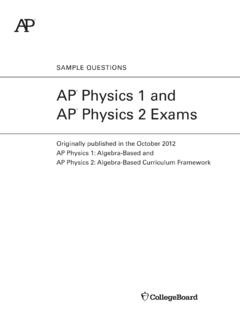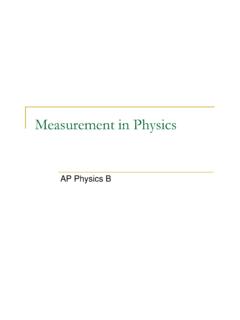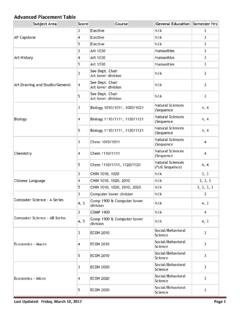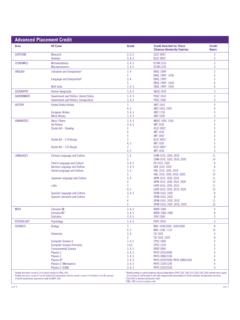Transcription of PREPARING FOR THE AP PHYSICS EXAM
1 PREPARING for the AP PHYSICS Exam Presented by Dolores Gende PREPARING for the AP PHYSICS Exam TABLE OF CONTENTS I. Understanding the AP PHYSICS Exam Multiple-Choice Questions 3 Free-Response Questions 12 II. Exam-Taking Strategies 16 III. Exam Preparation 18 IV. Exam Preparation Resources 21 2I. Understanding the AP PHYSICS Exam The AP PHYSICS B Exam takes three hours, and it is composed of two distinct sections. A section containing 70 multiple-choice questions makes up half of the exam, and the other half is a free-response section composed of multipart questions.
2 Each multiple-choice question offers five potential answers in a familiar standardized testing format. As in 2004, the free-response section of the PHYSICS B exam in 2005 will be slightly shorter than in the past, containing a total of 80 instead of 90 points. It will consist of two 15-point questions and five 10-point questions. However, the time allotment of 90 minutes for this section will remain the same, and the multiple-choice and free-response sections will still be weighted so that they each contribute 50 percent toward the total grade. The AP PHYSICS C Exam consists of two parts. One part covers mechanics, the other part electricity and magnetism. Each exam is one-and-a-half hours long. A student may take either or both parts, and a separate grade is reported for each.
3 In addition, the time for each part is divided equally between a 35-question multiple-choice section and a section with three free-response questions. Section I: Multiple-Choice Questions Calculators are not permitted during Section I of the exam. The relatively easy mathematical manipulation involved does not require their use, as numerical values are chosen to keep computation simple. Furthermore, the five potential answers listed for each question often differ to such a great degree that the correct choice can be determined by estimation. It would be useful for students to practice estimating calculated values. The AP PHYSICS Exam contains the following types of questions: Conceptual questions Computation questions: one-step and multiple-step Variable manipulation questions Graphical analysis questions Diagram-based questions Other types of questions Note: All examples have been taken from the 1998 Released Exams.
4 3 Conceptual Questions This type of question does not require a mathematical solution. Understanding the principles that underlie PHYSICS concepts is important as is knowing the relationships among variables. Some examples are: B1. A solid metal ball and a hollow plastic ball of the same external radius are released from rest in a large vacuum chamber. When each has fallen 1 m, they both have the same (A) inertia (B) speed (C) momentum (D) kinetic energy (E) change in potential energy B55. In an experiment, light of a particular wavelength is incident on a metal surface, and electrons are emitted from the surface as a result. To produce more electrons per unit time but with less kinetic energy per electron, the experimenter should do which of the following?
5 (A) Increase the intensity and decrease the wavelength of the light. (B) Increase the intensity and the wavelength of the light. (C) Decrease the intensity and the wavelength of the light. (D) Decrease the intensity and increase the wavelength of the light. (E) None of the above would produce the desired result. B64. Two parallel conducting plates, separated by a distance d, are connected to a battery of emf . Which of the following is correct if the plate separation is doubled while the battery remains connected? (A) The electric charge on the plates is doubled. (B) The electric charge on the plates is halved. (C) The potential difference between the plates is doubled. (D) The potential difference between the plates is halved.
6 (E) The capacitance is unchanged. Questions 7 8 refer to a ball that is tossed straight up from the surface of a small, spherical asteroid with no atmosphere. The ball rises to a height equal to the asteroid s radius and then falls straight down toward the surface of the asteroid. C7. What forces, if any, act on the ball while it is on the way up? (A) Only a decreasing gravitational force that acts downward (B) Only an increasing gravitational force that acts downward (C) Only a constant gravitational force that acts downward (D) Both a constant gravitational force that acts downward and a decreasing force that acts upward (E) No forces act on the ball. C8. The acceleration of the ball at the top of its path is (A) at its maximum value for the ball s flight (B) equal to the acceleration at the surface of the asteroid (C) equal to one-half the acceleration at the surface of the asteroid (D) equal to one-fourth the acceleration at the surface of the asteroid (E) zero C52.
7 In which of the following cases does there exist a nonzero magnetic field that can be conveniently determined by using Ampere s law? (A) Outside a point charge that is at rest (B) Inside a stationary cylinder carrying a uniformly distributed charge (C) Inside a very long current-carrying solenoid (D) At the center of a current-carrying loop of wire (E) Outside a square current-carrying loop of wire 4 Sometimes multiple-choice questions ask the student to identify the correct item or items from a list labeled with roman numerals. Some examples are: B5. Units of power include which of the following? I. Watt II. Joule per second III. Kilowatt-hour (A) I only (B) III only (C) I and II only (D) II and III only (E) I, II, and III B7.
8 Three forces act on an object. If the object is in translational equilibrium, which of the following must be true? I. The vector sum of the three forces must equal zero. II. The magnitudes of the three forces must be equal. III. All three forces must be parallel. (A) I only (B) II only (C) I and III only (D) II and III only (E) I, II, and III B11. Which of the following experiments provided evidence that electrons exhibit wave properties? I. Millikan oil-drop experiment II. Davisson-Germer electron-diffraction experiment III. J. J. Thomson s measurement of the charge-to-mass ratio of electrons (A) I only (B) II only (C) I and III only (D) II and III only (E) I, II, and III B12.
9 Quantities that are conserved in all nuclear reactions include which of the following? I. Electric charge II. Number of nuclei III. Number of protons (A) I only (B) II only (C) I and III only (D) II and III only (E) I, II, and III C11. A satellite of mass M moves in a circular orbit of radius R with constant speed V. True statements about this satellite include which of the following? I. Its angular speed is V/R. II. Its tangential acceleration is zero. III. The magnitude of its centripetal acceleration is constant. (A) I only (B) II only (C) I and III only (D) II and III only (E) I, II, and III Sometimes multiple-choice questions ask the student to select items from two or three columns.
10 Some examples are: B27. When light passes from air into water, the frequency of the light remains the same. What happens to the speed and the wavelength of light as it crosses the boundary in going from air into water? Speed Wavelength (A) Increases Remains the same (B) Remains the same Decreases (C) Remains the same Remains the same (D) Decreases Increases (E) Decreases Decreases C2. The velocity of a projectile at launch has a horizontal component Vh and a vertical component Vv. Air resistance is negligible. When the projectile is at the highest point of its trajectory, which of the following show the vertical and horizontal components of its velocity and the vertical component of its acceleration?






